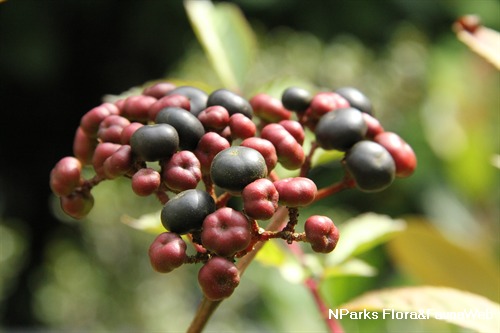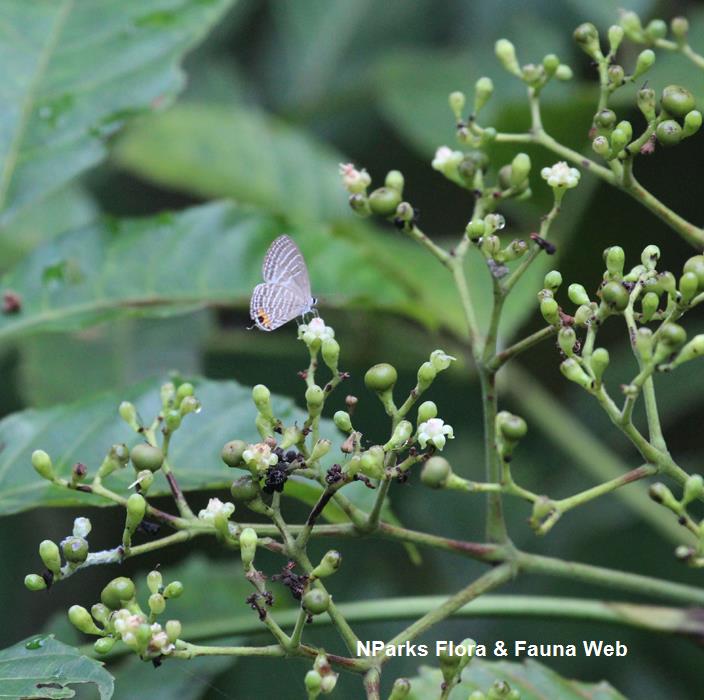
Back
Leea rubra Blume
| Family Name: | Vitaceae |
| Common Name: | Mali-mali Puchok Merah, Red Leea, Mali-Mali, Red Tree-Vine, Red Tree Shrub |
Name
Classifications and Characteristics
| Plant Division | Angiosperms (Flowering Seed Plants) (Dicotyledon) |
|---|---|
| Plant Growth Form | Shrub |
| Lifespan (in Singapore) | Perennial |
| Mode of Nutrition | Autotrophic |
| Plant Shape | Irregular |
| Maximum Height | 3 m |
Biogeography
| Native Distribution | India, Bangladesh, Myanmar, Thailand, Cambodia, Laos, Vietnam, Malaysia, Singapore, Philippines, Indonesia, New Guinea to northern Australia |
|---|---|
| Native Habitat | Terrestrial (Secondary Rainforest, Monsoon Forest, Grassland / Savannah/ Scrubland, Primary Rainforest) |
| Preferred Climate Zone | Tropical, Sub-Tropical / Monsoonal |
| Local Conservation Status | Native to Singapore (Presumed Nationally Extinct (NEx)) |
Description and Ethnobotany
| Growth Form | It is a semi-woody shrub up to 3 m tall. |
|---|---|
| Foliage | Its alternate, stalked, 2-4 pinnate leaves are 30-60 cm long, with many leaflets. |
| Flowers | Its flowering shoots are compact and 4-16 cm long. Flowers are bright red in colour with a yellow central disc. |
| Fruit | It fruits are subglobose berries, turning dark red or purple when ripe, 6-seeded, 7-10 mm wide. |
| Habitat | It grows in dry monsoon forest, savanna, primary and secondary forests up to 500 m altitude. |
| Associated Fauna | Its flowers are pollinated by insects and butterflies. The fruits are eaten by birds and other small mammals. |
| Cultivation | It can be propagated by seed or stem cutting. |
| Etymology | Latin Leea, a name for tropical small trees or shrubs named for James Lee (1715–1795), who was a nurseryman; Latin rubra, red, referring to the colour of the flowers. |
| Ethnobotanical Uses | Medicinal: Leaves are used as a poultice to treat wounds. The roots are used for reducing fevers and inducing perspiration and for treating arthritis, rheumatism and stomachaches. It is also mixed with arsenic to treat yaws. Fruits are also consumed to treat dysentery and yaws. |
Landscaping Features
| Landscaping | It is suitable for planting along streetscapes, parks and gardens for its attractive bright red flowers. |
|---|---|
| Desirable Plant Features | Ornamental Flowers, Ornamental Stems, Ornamental Foliage, Ornamental Fruits |
| Landscape Uses | General, Flowerbed / Border, Hedge / Screening, Suitable for Roadsides, Parks & Gardens, Small Gardens |
Fauna, Pollination and Dispersal
| Fauna Pollination Dispersal Associated Fauna | Bird-Attracting (Fruits), Butterfly-Attracting (Flower Nectar), Bee-Attracting |
|---|---|
| Pollination Method(s) | Biotic (Fauna) (Insects (Bee), Insects (Butterfly, Moth), Insects (Ant, Beetle, Fly, Thrip, Wasp)) |
| Seed or Spore Dispersal | Biotic (Fauna) |
Plant Care and Propagation
| Light Preference | Full Sun |
|---|---|
| Water Preference | Moderate Water |
| Plant Growth Rate | Moderate |
| Rootzone Tolerance | Moist Soils, Well-Drained Soils, Fertile Loamy Soils |
Foliar
| Mature Foliage Colour(s) | Green, Red |
|---|---|
| Prominent Young Flush Colour(s) | Red |
| Foliar Arrangement Along Stem | Alternate |
| Leaf Area Index (LAI) for Green Plot Ratio | 4.5 (Shrub & Groundcover - Dicot) |
Floral (Angiosperm)
| Flower & Plant Sexuality | Bisexual Flowers |
| Flower Colour(s) | Red, White, Yellow / Golden |
|---|---|
| Flower Grouping | Cluster / Inflorescence |
| Flower Location | Terminal |
| Flower Symmetry | Radial |
Fruit, Seed and Spore
| Mature Fruit Colour(s) | Red, Purple |
|---|---|
| Mature Fruit Texture(s) | Smooth |
| Fruit Classification | Simple Fruit |
| Fruit Type | |
| Seed Quantity Per Fruit | Moderate (6-10) |
References
| References | PlantUse English contributors, "Leea rubra (PROSEA)," PlantUse English. https://uses.plantnet-project.org/e/index.php?title=Leea_rubra_(PROSEA)&oldid=215889. Accessed 12 Oct. 2022. |
|---|
Image Repository
Others
| Master ID | 898 |
|---|---|
| Species ID | 2192 |
| Flora Disclaimer | The information in this website has been compiled from reliable sources, such as reference works on medicinal plants. It is not a substitute for medical advice or treatment and NParks does not purport to provide any medical advice. Readers should always consult his/her physician before using or consuming a plant for medicinal purposes. |















